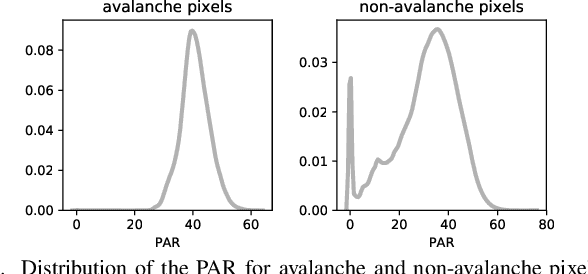Jakob Grahn
Monitoring snow avalanches from SAR data with deep learning
Feb 25, 2025Abstract:Snow avalanches present significant risks to human life and infrastructure, particularly in mountainous regions, making effective monitoring crucial. Traditional monitoring methods, such as field observations, are limited by accessibility, weather conditions, and cost. Satellite-borne Synthetic Aperture Radar (SAR) data has become an important tool for large-scale avalanche detection, as it can capture data in all weather conditions and across remote areas. However, traditional processing methods struggle with the complexity and variability of avalanches. This chapter reviews the application of deep learning for detecting and segmenting snow avalanches from SAR data. Early efforts focused on the binary classification of SAR images, while recent advances have enabled pixel-level segmentation, providing greater accuracy and spatial resolution. A case study using Sentinel-1 SAR data demonstrates the effectiveness of deep learning models for avalanche segmentation, achieving superior results over traditional methods. We also present an extension of this work, testing recent state-of-the-art segmentation architectures on an expanded dataset of over 4,500 annotated SAR images. The best-performing model among those tested was applied for large-scale avalanche detection across the whole of Norway, revealing important spatial and temporal patterns over several winter seasons.
Recognition of polar lows in Sentinel-1 SAR images with deep learning
Mar 30, 2022



Abstract:In this paper, we explore the possibility of detecting polar lows in C-band SAR images by means of deep learning. Specifically, we introduce a novel dataset consisting of Sentinel-1 images labeled as positive; representing a maritime mesocyclone, or negative; representing a normal sea state. The dataset is constructed using the ERA5 dataset as baseline and it consists of 2004 annotated images. To our knowledge, this is the first dataset of its kind to be publicly released. The dataset is used to train a deep learning model to classify the labeled images. Evaluated on an independent test set, the model yields an F-1 score of 0.95, indicating that polar lows can be consistently detected from SAR images. Interpretability techniques applied to the deep learning model reveal that atmospheric fronts and cyclonic eyes are key features in the classification. Moreover, experimental results show that the model is accurate even if: (i) such features are significantly cropped due to the limited swath width of the SAR, (ii) the features are partly covered by sea ice and (iii) land is covering significant parts of the images. By evaluating the model performance on multiple input image resolutions (pixel sizes of 500m, 1km and 2km), it is found that higher resolution yield the best performance. This emphasises the potential of using high resolution sensors like SAR for detecting polar lows, as compared to conventionally used sensors such as scatterometers.
Snow avalanche segmentation in SAR images with Fully Convolutional Neural Networks
Oct 11, 2019



Abstract:Knowledge about frequency and location of snow avalanche activity is essential for forecasting and mapping of snow avalanche hazard. Traditional field monitoring of avalanche activity has limitations, especially when surveying large and remote areas. In recent years, avalanche detection in Sentinel-1 radar satellite imagery has been developed to overcome this monitoring problem. Current state-of-the-art detection algorithms, based on radar signal processing techniques, have highly varying accuracy that is on average much lower than the accuracy of visual detections from human experts. To reduce this gap, we propose a deep learning architecture for detecting avalanches in Sentinel-1 radar images. We trained a neural network on 6345 manually labelled avalanches from 117 Sentinel-1 images, each one consisting of six channels with backscatter and topographical information. Then, we tested the best network configuration on one additional SAR image. Comparing to the manual labelling (the gold standard), we achieved an F1 score above 66%, while the state-of-the-art detection algorithm produced an F1 score of 38%. A visual interpretation of the network's results shows that it only fails to detect small avalanches, while it manages to detect some that were not labelled by the human expert.
 Add to Chrome
Add to Chrome Add to Firefox
Add to Firefox Add to Edge
Add to Edge